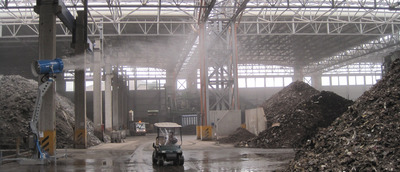Dust: an explosive risk
History is littered with incidents of catastrophic dust explosions. It is possible, however, to minimise the risk by identifying and mitigating contributing factors.
To many, dust can seem harmless. But if certain conditions prevail, it can pose a deadly problem.
“For a dust explosion to occur, several contributing factors must be present,” said Graeme Cooper, Managing Director of Tecpro Australia. “First of all, there must be airborne, combustible dust in high concentrations. The environment will also contain an oxidising agent such as oxygen, and the explosion is triggered by a source of ignition such as a flame or static electricity.”

Over the centuries, dust explosions have claimed many lives and caused significant injuries and property damage. Typically occurring in contained environments such as underground mines, mills and storage facilities, a wide range of dust types are combustible, including coal, grain, flour, sugar, sawdust, magnesium, cotton and even powdered metals such as titanium and aluminium.
“When a product is broken down into dust particles, its total surface area increases dramatically,” said Cooper. “This makes it much more flammable.”
Cooper said one of the biggest problems is that it is sometimes difficult to perceive dust as a real threat to safety. “In settings where there is the odour of gas or flammable vapours, it’s obvious that there is an explosion risk and people are usually quick to respond and combat the problem,” he said. “In contrast, where there is a large build up of dust, it may not necessarily make people in the area think about the possibility of an explosion risk.”
Lower-grade dust explosions where there is no damage to people or property can also create a false sense of security. “If relatively minor dust explosions occur, sometimes people feel complacent and that the problem is more or less manageable. However this doesn’t necessarily mean that future explosions won’t escalate into a larger disaster,” said Cooper. “Smaller dust explosions can unsettle dust elsewhere, causing rolling explosions which can, of course, do great damage. It’s best to be vigilant and proactive by eliminating or minimising the factors that can contribute to a dust explosion.”
Tecpro Australia is routinely called upon to offer advice and solutions regarding dust control and risk mitigation.
“We’ve developed a large number of dust suppression solutions for a range of environments including coal mines, transfer stations, grain storage facilities, rubbish dumps, concrete manufacturing plants and more,” said Cooper. “We look carefully at each situation and customise a dust suppression solution to match the nature of the dust and its setting.”
Tecpro’s expertise was recently acknowledged when the company won the 2012 Australian Bulk Handling Review Award for Dust Control, Technology, Application or Practice in partnership with the University of Wollongong.
“There have been many horrific dust explosions throughout the world over the years and we’re keen to make people stop and think about whether there is a risk of this occurring in their work environment,” said Cooper. “Tecpro has the skills and experience to advise on solutions that can greatly reduce the risk.”
Source: http://www.foodprocessing.com.au/articles/61981-Dust-an-explosive-risk
New workplace exposure limits for airborne contaminants
The workplace exposure limits for airborne contaminants (WEL list) will be adopted throughout...
New exposure standard to improve welder safety outcomes
Work Health and Safety Ministers have agreed to reduce the workplace exposure standard for...
New campaign shines light on safe gas appliance use
Resources Safety and Health Queensland (RSHQ) has launched a campaign to ensure small food...








